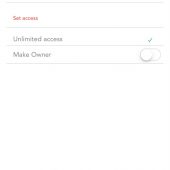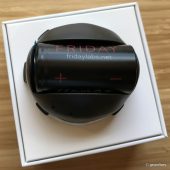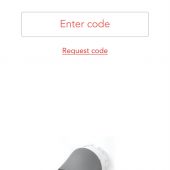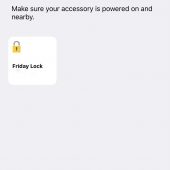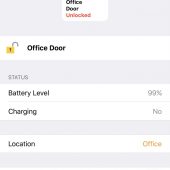In the last few years, the smarthome accessory market has exploded. Now it’s possible for anyone to make their home more automated, efficient, and yes, smarter to add aftermarket accessories that remotely control or oversee their home’s temperature, energy efficiency, who’s in their home, who has access to their home, and more. Which brings us to the Friday Lock.

The Friday Lock is billed as the “world’s smallest smart lock”; it fits over the inside bits of your existing deadbolt, rather than making you replace the entire unit. This does, indeed, make it smaller than it’s other connected deadbolt replacement competitors.
The Friday Lock connects to your phone wirelessly via Bluetooth, and you can use the Friday Lock app to lock or unlock your door’s deadbolt without a key. You can use the app to grant access to your door to others — by setting them up as a regular user and then revoking their access once you don’t want them to have it anymore. You can also open the door remotely for people who need to enter your home while you are away. The app will keep track of exactly who goes in and out of your door (when they are registered as guests) or who unlocks or locks the door (when access is granted remotely).
While the Friday Lock site and their original Indiegogo campaign mention being able to grant people encrypted keys that are good for a certain amount of time, there doesn’t appear to be a way to do this — at least, not yet. Instead, you can invite people from your contact list to either be a guest or an owner. The only access that you are allowed to grant these guests is unlimited (it’s impossible to uncheck that option), or you can upgrade that guest to an owner.
So let’s take a look at the Friday Lock and see if it might work for you, your home, and your situation.
The Friday Lock is available in a variety of finishes to match your door’s hardware and your interior.

The Friday Lock came to me in two boxes. The first held the lock mechanism with a 3000mAh battery installed, two tailpiece adapters, a second 3,000mAh battery, and a USB charger. The second box held a universal backplate (useful if your tailpiece is a bit longer and you don’t want to trim it or if you just like the way it looks) and a metal knob/shell cover. The box says the shell is steel, but it looks like nickel satin to me; it’s beautiful, and it perfectly matches my existing hardware.
With all the pieces laid out in front of you, it’s time to take apart the deadbolt that you will be modifying. This is my old deadbolt knob. You’ll notice that it’s the typical type (nothing special), and to be honest, I felt like it was sloppily installed as it rattled a bit. But anyway.
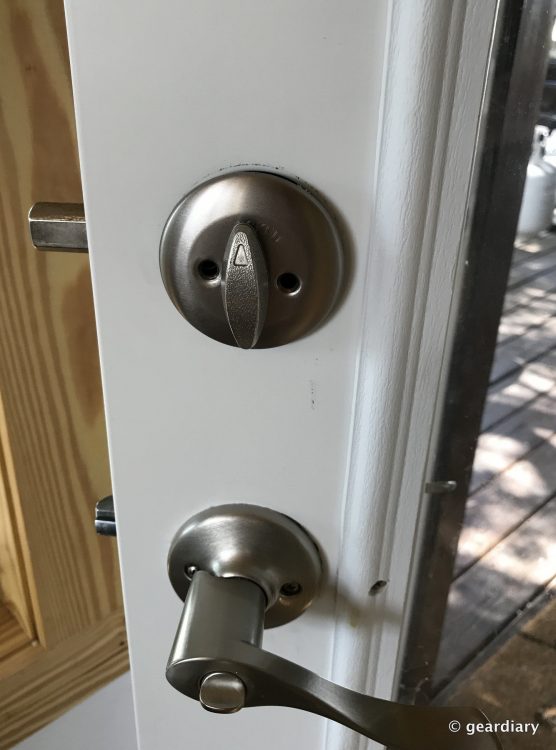
With the knob turned up so I could access the screws, I just needed a Phillips head screwdriver to remove them. I set the knob and the two long screws to the side because I knew I’d need the long screws later to attach the Friday Lock.

That U-shaped middle thing is called a tailpiece. Mine isn’t very long, so I won’t need the backplate. That’s too bad because I think it would have looked nice.
These are the two included tailpiece adapters. They fit over the tailpiece, and they have gear notches on the outer edges to connect with the turning mechanism of the Friday Lock.

Here’s a picture of the faceplate with the Friday lock (without the battery) installed on my door. The tailpiece is just a wee bit too short for the tailpiece adapter to properly grab, so when I do the final install, it will have to be without the faceplate.
- Nothing is actually holding the tailpiece adapter in place before you add the battery, so be careful you don’t drop it or send it flying. 😉
From these angles, you can see the slot on each side (next to the + and – signs) where a credit card can be inserted once the metal shell is installed to release the cover. The main reason for ever having to do that will be for replacing the battery to load a fresh one when the charge is low; Friday says that will be about 3 months.
When you first receive your Friday Lock, the battery will be charged from the factory a maximum of 30%; you should use the included USB charger to top the battery off before installing it.
Once the battery is installed, you’ll see a green pairing light; the hole to the right of it is the reset button; I haven’t had to use my reset button yet, but if you have any difficulty pairing, it should help.

At this point, you should download the Friday Lock app from the Apple App Store or Google Play; if you are using an iOS device, the lock will ask if you’d like to also use Apple HomeKit.
I’m using an iPhone and Apple Home Kit for the install, so I allowed the permissions and set it up accordingly. Once the install is complete, you’ll need to calibrate the Friday Lock to know when the deadbolt is opened and closed through its app.
The beauty of the Friday Lock is that it replaces the interior side of just about any deadbolt, so you will still be able to use the keys you already own on the exterior of the door should you ever need manual access. This is the perfect “dumb home” solution, should the “smart home” solution ever fail you.
Even if it weren’t a smart deadbolt, I think that the new lock cover looks better on the door than the thinner, old-fashioned deadbolt’s thumb turner; so you can add that to the Friday Lock’s plus column.

All of the Friday Lock components appear to be very well made, and I think you can agree with me that the finished product when installed is aesthetically pleasing.
This is the full user manual that should have been included with the Friday Lock. The one that ships with the box is just a 4-page quick start guide — mainly telling you to download the app and how to pair the app with the lock, with basic info on how the lock works. You should definitely look at the online manual before you get started, as it includes useful installation information.

The quick start guide does include a handy measurement template so you can tell if you’ll need to trim your deadbolt’s tailpiece with a hacksaw or not.
So how does the lock work?
If you are using the Friday Lock app only, either on an Android or iOS device, then it connects to your phone via Bluetooth; you can control it via the BT connection when you are within a certain distance of the lock, but otherwise, there is no remote access.
I tested this by trying to unlock the lock with my BlackBerry KEYone from about 100 feet away (too far for most Bluetooth applications to work). As you can see, the lock is grayed out and there is no access.

When you use the Friday Lock app on iPhone from more than 100 feet away, you get a connection error.
If you have the Friday Lock paired with Apple HomeKit, and you are using your Apple TV or a stay-at-home always-on iPad as your Home Hub, then you will have remote access the lock wirelessly from almost anywhere in the world.

Here’s a quick video of the lock in action, using HomeKit.
The Friday Lock app keeps a record of anyone you have sent access to, and it keeps a record of anyone who has used the app to lock or unlock the deadbolt.

It is possible to check the battery status through the Apple Home app: A long press on the lock icon, then pressing the details tab will bring up the information.
Missing is the WiFi ability that was promised when the Friday Lock originally ran their Indiegogo campaign. While HomeKit/Home Hub integration is great for remote access from an iOS device, it doesn’t help anyone who is using an Android device.
As far as geofencing lock assistance goes, if you are using an Android device, the Friday Lock will unlock the door for you as you approach it if you follow these steps:
Turn on Assist unlock when standing near to the lock. Lock the door with the app. Leave the house, you need to move at least 300 metres away.A notification should tell you when you have left the geofence area. Head back towards the door, you will see another notification telling you have entered the geofence area. The lock will scan for up to 30 minutes looking for the lock and then open it when it finds it, should be within a few metres of the lock.
Let’s watch this original campaign video together, and I’ll tell you which promises the Friday Lock fulfilled and which have not yet been met …
- “Total control over your door lock — even when you’re not at home”: To a point — as long as you are using Apple HomeKit.
- “Friday connects to your smartphone via Bluetooth or WiFi”: At least right now, it’s Bluetooth only, which means you must be within 40 feet or so for the lock to work with the app (unless you are using HomeKit with a Home Hub).
- You can grant secure remote access to your friends as few or as many times as you’d like”: Sure — but if you set them up as guests, they’ll have unlimited access until you revoke it; otherwise it’s a matter of them calling you and you unlocking the door for them remotely (once again, only if you have Apple HomeKit with a Home Hub).
- “Friday automatically unlocks your door for you when you come home and locks it when you leave”: There is no geofencing option that I’ve found that will allow you to do this (yet) on iOS devices, but this feature does work on Android.
I looked through all of the campaign updates, and I found a post on May 14th saying the following:
It’s become apparent that there is a very high expectation of the Friday lock’s feature set based upon the fact that it also supports Wi-Fi.
The Friday lock’s primary method for local communication is Bluetooth Low Energy (BLE), the reason for this is that it uses very little battery power as the name suggests. Wi-Fi is almost ubiquitous these days but it has one major flaw – that it is very power hungry. For this reason we will only use the Wi-Fi for selective features where it can be on for a very short duration, then immediately turned off again. Any feature that would require the lock to be permanently “listening” (for example lock/unlock) is implemented using BLE only, in order to have an acceptable (measured in months) battery life.
Over time we will be releasing more features that use Wi-Fi, but only if they do not have a significant detrimental affect on battery life.
We do understand that there are occasions when it would be advantageous to communicate with the lock at all times from a distance – currently our solution is to use HomeKit but we are also investigating other ways to achieve this both for Android as well as iOS users.
So to summarize: The Friday Lock works well enough remotely with HomeKit using a Home Hub. It allows you to keep your existing deadbolt and key, as it only replaces the interior thumb lock. This is a great setup on the surface, but the promised smart features like being able to grant remote access to your friends through the app is a premise that hasn’t quite been finely tuned, and the lock will not automatically lock or unlock the door as you approach it unless you have an Android device. If you can live with those limitations, then you may be happy with the Friday Lock. For my use, it is working well, and I’ve had no issues with it.
The Friday Lock retails for $249, and it is available directly from the manufacturer and from other retailers including Best Buy (satin nickel finish only).
Source: Manufacturer supplied review sample
What I Like: The Friday Lock allows you to keep the deadbolt mechanism and original key for your door, as it only replaces the thumb lock on the inside; The Friday Lock shell is beautiful, and it will look good in any interior on any door; The lock is easy enough to install; The Friday Lock works very well remotely with Apple Home Kit if you have a Home Hub set up; You can add other users and owners to the account through the Friday Lock app; There is a Friday Lock app for both Android and iOS; Geo-fencing (for automatic locking and unlocking within a certain area) works with Android devices
What Needs Improvement: There is no way to access the lock remotely if you don’t use Apple HomeKit with a Home Hub; There is no real way to set up temporary access that involves assigning people certain days or times that they can unlock or lock the deadbolt; There is no geofencing ability (as of yet) for iOS devices that will lock or unlock your door as you leave or come in


